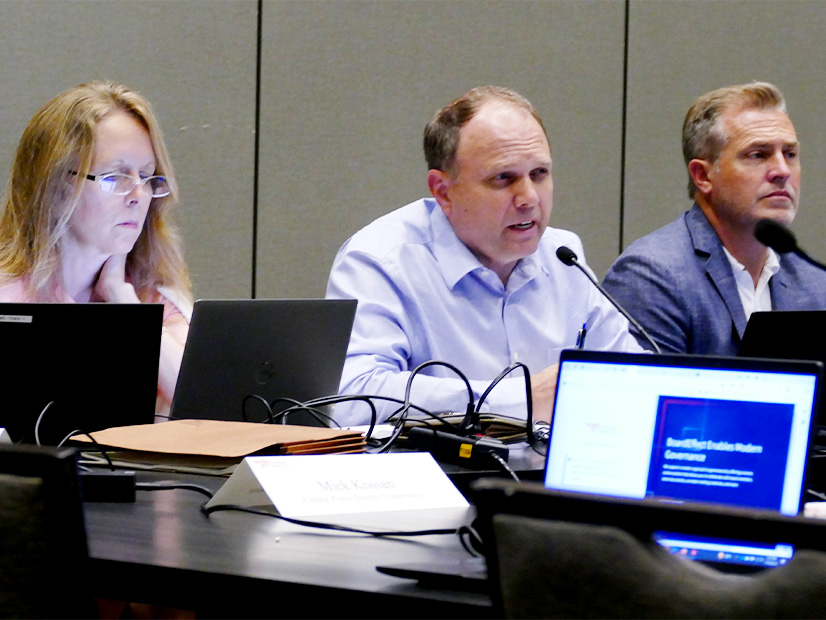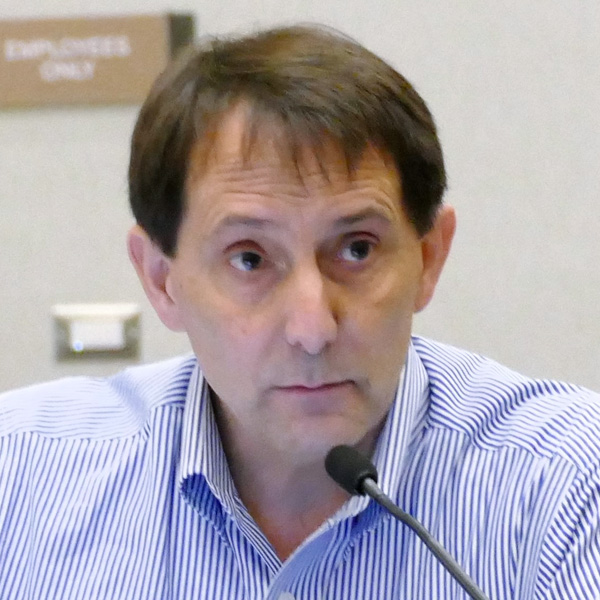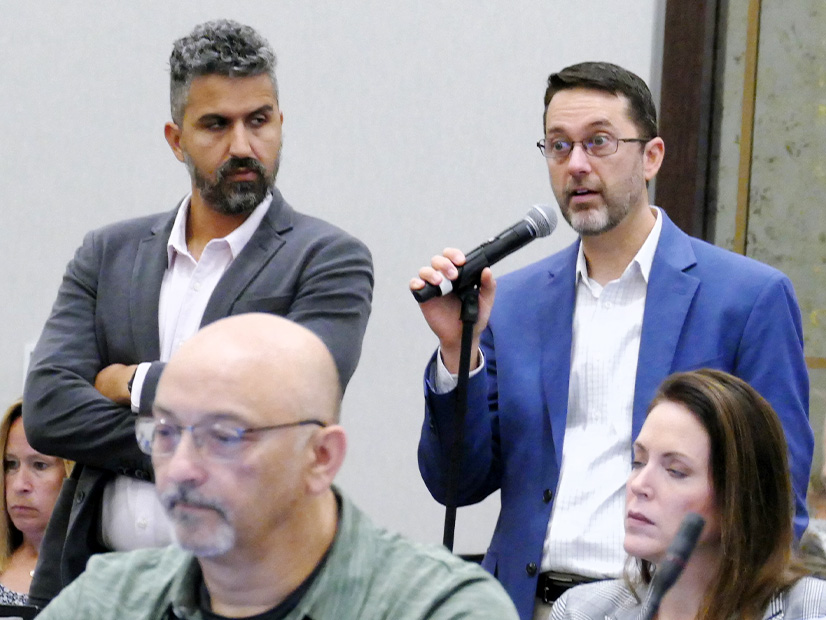
SPP stakeholders endorsed a tariff revision request that adds a winter resource adequacy requirement for load-responsible entities bound by the grid operator’s recent planning reserve margin increase.
Members Endorse Winter Resource Adequacy Requirement for 2024/25
OMAHA, Neb. — SPP stakeholders last week endorsed a tariff revision request that adds a winter resource adequacy requirement for load-responsible entities (LREs) bound by the grid operator’s recent planning reserve margin (PRM) increase.
However, the measure approved by the Markets and Operations Policy Committee during its July 10-11 meeting is likely to encounter headwinds from SPP’s state regulators and the Board of Directors when they hold their quarterly meetings next week.
The revision request (RR549) applies the same level of validation, study and assessment requirements to the winter season (December through March) that currently applies to the summer season, including a deficiency payment for capacity shortfalls. The measure also assigns an annual deficiency payment to prevent duplicate payments for the same capacity within an annual timeframe.
The tariff change met MOPC’s 66% averaged approval threshold at 67.2%, with 87.5% of transmission owners and 47% of transmission users voting for the revision. It is effective for the 2024/25 winter.
Director Steve Wright signaled to committee members that RR549 almost assuredly will meet resistance before the Regional State Committee and board next week. He said he was concerned about modified language that American Electric Power offered during the discussion and was accepted by the sponsoring stakeholder group as a friendly amendment. He said adding the PRM’s calculation to the tariff “exposes it to litigation at FERC.”
“That was a tough discussion with respect to whether to move forward now or try to perfect the resolution,” Wright said. “The discussion is there; the debate is there; the members came to a decision. Rather than adding a process requirement regarding the calculation of the PRM with a fairly vague standard and putting that into the tariff … I think that deserves a lot more discussion. For me, it takes us in a different direction. I hope there will be a continued discussion in the next two weeks.”
MOPC Chair Alan Myers, with ITC Holdings, said the Cost Allocation Working Group’s (CAWG) original version of the tariff change could be offered up to the RSC and board. Staff secretary Lanny Nickell said the time between the MOPC and RSC meetings will give staff and legal an opportunity to develop alternatives to the amended language.
AEP’s revisions require transmission providers to detail the methodology used in loss-of-load expectation studies and to determine the final PRM value based on their results. It said it was concerned the CAWG’s proposed language facilitates PRM changes without providing LREs adequate time to comply and that neither the tariff nor the planning criteria provide a transparent process for stakeholders to validate SPP’s determination or, on their own, forecast future PRM values.
“‘The final results of the LOLE study’ implies it is a simple formulaic result, when in fact it requires the application of judgment among many results,” AEP’s Richard Ross said.
The PRM was raised last summer and added to SPP’s planning criteria despite pushback from members. (See SPP Board, Regulators Side with Staff over Reserve Margin.)
The summer requirement already is in place this year. According to SPP’s 2023 resource adequacy report, all LREs complied with the summer RAR. Sixty LREs met the new 15% PRM requirement passed last year, and one met the 9.89% PRM requirement because its capacity is at least 75% hydro-based generation.
SPP’s Market Monitoring Unit supports a winter RAR but recommended remanding RR549 back to the CAWG to address its concerns. The MMU said that, as written, the tariff doesn’t include language requiring a reasonable expectation of availability for resources used toward RAR; it doesn’t achieve the policy’s goal for the deficiency payment; and the deficiency calculation does not send the appropriate signal to improve available accredited capacity.
MMU Comments Bypassed in Order 881 Compliance
MOPC endorsed a tariff change that SPP legal staff believe complies with FERC Order 881, which directs transmission providers to use ambient-adjusted ratings (AARs) for short-term transmission requests — 10 days or less — for all lines that are affected by air temperature. Seasonal ratings will be required for long-term service. (See FERC Orders End to Static Tx Line Ratings.)
RR565 is a response to FERC’s deficiency letter in May. The commission ruled SPP was noncompliant and directed it to use AARs for any seams-based transmission service; explain its timelines for calculating or submitting AARs; and address systems and procedures so TOs can update their line ratings at least hourly (ER22-2339).
The MMU said the measure does not address some of FERC’s determinations and recommended its own edits. It proposed replacing three sentences approved by the Operating Reliability Working Group (ORWG) with six paragraphs that it said address line ratings’ and methodologies’ “transparency and accuracy.” It also recommended adding transparency indicating the market processes that will use the line ratings.
However, MOPC declined to consider the edits. It passed the ORWG’s recommended version with a 95.56 average.
ORWG Vice Chair Jeff Wells, with Grand River Dam Authority, agreed that the measure’s language doesn’t address all that was required by FERC. He said a procedure manual will outline the process for implementing AARs and “address the unknown.”
“We were trying to keep the tariff concise, to be concise with the wording and what’s required by the tariff,” Wells said, adding that “accommodations” were made to give TOs the flexibility they need to adhere to the requirements “without being burdensome beyond what was required.”
Addressing concerns over the validation process, Keith Collins, vice president of the MMU, said Order 881 requires market monitors to be included. He said SPP will ensure appropriate line ratings or replacements up front, with the MMU taking over after the fact to look at gaming opportunities or market inefficiencies.
“FERC requires the market monitors to validate and have a role in the process. It’s not optional,” Collins said.
He said RR565 likely will be on the board’s consent agenda when it meets next week. MMU staff will evaluate whether to ask that it be pulled off and considered separately, Collins said. The Monitor also could intervene at FERC, which it has done in the past.
“That’s our general practice,” he told RTO Insider. “However, if we’re going to raise a concern with FERC, we would like to ensure that the board has had an opportunity to understand our concerns.”
The commission has granted the RTO an extension to Aug. 1 to make its second compliance filing.
GI Backlog Halfway Completed
SPP celebrated the halfway point of clearing its generator interconnection queue by issuing a press release highlighting its mitigation strategies as paving the way “for the construction of dozens of new resources.”
The RTO credited the backlog mitigation plan with executing GI agreements that will add more than 14.5 GW of new generation to the system over the next four years. SPP has added almost 28 GW of capacity to the system since 2017, when the backlog began.
FERC approved SPP’s backlog mitigation plan, designed to simplify and reduce study timelines, in January 2022. It has completed two cluster studies since, with the five remaining clusters on track to be finished next year. (See “GI Backlog Plan Approved,” FERC Denies Co-ops’ $79M Complaint vs. SPP.)
The queue still has 561 active requests for 112 GW of generation (108 GW of renewable resources) left, with about 220 of the requests submitted last year.
MOPC separately approved RR493, which consolidates language from several existing business practices and the Definitive Interconnection System Impact Studies (DISIS) manual into a standalone GI manual. It also adds GI special studies to the manual and a fuel-based dispatch option to the second study phase.
The measure revises the existing fuel-based dispatch methodology to dispatch non-legacy ITP generators without firm transmission service at the same percentage as non-ITP generators with higher queue priority.
Staff said they had some concerns about RR493’s additional responsibilities in resolving the queue’s backlog, but they supported the measure and would provide a more thorough impact assessment during MOPC’s January meeting.
“SPP staff can support this particular motion because it baselines the manual. … We’re going to have to go through an exercise to determine the overall impact,” said Casey Cathey, SPP’s director of grid asset utilization. “We have actually doubled the very next DISIS, so we’re kind of going into it with eyes wide open.”
SPP Self-reports to FERC
Nickell drew some smiles when he told the committee SPP had filed a self-report with FERC in March. The smirks turned into chuckles when he admitted he had forgotten to pass along the information during the committee’s April meeting.
“My mistake. I’m just now catching up,” he said.
Staff discovered this year that in 2020, they had incorrectly assigned Kansas City Board of Public Utilities (KCBPU) as a transmission-owning member in its electronic ballot tool, rather than as a transmission-using member. Staff reviewed the votes taken since then and discovered the error affected only one vote: approving the PRM’s increase to 15% during the October MOPC meeting. (See “Members Address Resource Adequacy,” SPP Markets and Operations Policy Committee Briefs: Oct. 10-11, 2022.)
MOPC votes require a two-thirds vote, equally weighted between TOs and TUs, for approval. The PRM measure passed with 66.29% approval, with KCBPU voting “yes” as a TO. Nickell said had the utility been assigned correctly as a TU, the PRM vote would have failed at 65.63%.
The board and state regulators approved the PRM’s increase last July. The October vote simply endorsed RR516 as implementing the increase.
“We think the outcome is inconsequential,” Nickell said. However, because staff changed the vote, SPP reported the change to FERC.
SPP General Counsel Paul Suskie said the industry makes similar self-reports “all the time.”
20-year Tx Assessment Endorsed
Stakeholders unanimously endorsed a 20-year assessment of long-range extra-high-voltage (EHV) transmission needs that says SPP will need between 900 and 1,200 miles of new EHV lines that could enable carbon dioxide reductions of up to 93%.
The study team evaluated 463 solutions during its 35-month analysis. It found the solutions could cost as much as $1.55 billion in engineering and construction costs across its reference case and emerging technologies cases, with a benefit-to-cost ratio of $1.57 billion to $4.35 billion. The assessment does not request notifications to construct, but it did recommend 13 new transmission projects to resolve congestion and other constraints.
The study was due before the end of last year. The next 20-year assessment is targeted for 2027.
“For us to really realize the [20-year assessment’s] value, we’ve got to do these much faster,” said David Kelley, vice president of engineering. “This becomes much more valuable information because, as we all know, our industry is changing much faster than any of us thought was ever possible just a few years ago.”
After receiving feedback from members about media reports that focused on the assessment’s costs, SPP staff clarified that the 20-year study is intended to develop a long-range EHV (considered 300 kV or more) transmission road map for the SPP region. It also identifies projects that economically deliver energy and addresses future industry uncertainty; the identified projects will provide candidates that inform shorter-term planning assessments.
Winter Models to Reflect Uri
The Transmission Working Group updated MOPC on its discussions with the Economic Studies Working Group over the 2024 ITP’s winter weather assessment.
A strike team decided that regional winter models should be more reflective of the February 2021 winter storm (also known as Uri), which had a large impact on the natural gas supply and limited renewables’ production.
Stakeholders have chosen accuracy over precision in using historical data to model the effects on the footprint’s different subregions, similar to a load-forecast approach.
Several other stakeholder groups also briefed the committee:
-
- The Project Cost Working Group has created an in-service date delay report that will be added to the quarterly project tracking report and list network upgrades with estimated in-service dates at least one year past. Staff will review the new report with the working group each quarter and provide updates to MOPC and other stakeholder groups as needed. The increased awareness already has resulted in 18 completed and previously delayed upgrades at a cost of $146 million, said group Chair Brian Johnson, with AEP.
- The Strategic and Creative Re-engineering of Integrated Planning Team’s Consolidated Planning Process Task Force is drafting a white paper to “button up” the first phase of its proposed consolidated planning process following “a lot of healthy discussion,” SPP’s Sunny Raheem said. The stakeholder group still must determine an entry fee rate-structure design for cost-sharing and recovery and transition plan recommendations, and continue developing phase 1 policy recommendations.
Zonal Criteria Voting Changed
Members unanimously approved its consent agenda, but not before National Grid Renewables Energy Marketing pulled RR557 for separate consideration. The measure, which passed with opposing votes from National Grid and two other transmission users, updates the zonal planning criteria voting process so absent and abstention votes no longer are counted as “no” votes and are not included in the final tally.
National Grid’s Margaret Kristian said the smaller denominator creates a low bar for approval with abstentions or absent votes. “We think that the recording of approval should really be in the affirmative on the new policy, and that the kind of default action should not necessarily be to approve without the majority,” she said.
The consent agenda included scope updates to the 2024 ITP that document a new vendor for the long-term natural gas pricing outlook and defining extreme winter weather model scenarios needs; endorsement of a sponsored upgrade study for 161-kV work in Omaha; and nine additional RRs that would:
-
- RR521: clarify that market participants registering auxiliary load must ensure that it is consistent with any legal or regulatory requirements applicable to the auxiliary load or the entity serving the load.
- RR542: define aggregator of retail customers (ARC) and differentiate between certification and attestation requirements for ARCs and other aggregators registering under FERC Order 719.
- RR543: require market participants registering demand response resources (DRRs) to verify that critical load is not being registered as a DRR and that the registered capacity does not exceed the load’s hourly maximum within the previous year; and clarify the dispute process between the market participant, retail provider and relevant retail regulatory authority for DRRs.
- RR547: eliminate the need for the MMU to pass an annual revision request updating the variable operations and maintenance escalation index that can be computed from publicly available Bureau of Labor Statistics data.
- RR548: eliminate the rarely used screening study processes for long-term service requests (LTSR) and delivery point transfers (DPT) and incorporate the DPT into the consolidated planning process.
- RR552: do away with the ITP manual’s requirement removing the firm service requirement for resource inclusion in the base reliability power-flow models.
- RR553: ensure all uncertainty product revision requests (RR449, RR496, RR535) are implemented correctly.
- RR561: clarify the overall multiday reliability assessment (MDRA) process and how the day-ahead market will consume its commitments, how they are compensated through settlements and which resource offer costs are used for recovery.
- RR569: correct the settlements protocols to ensure multiday minimum run time and settlement calculation cleanup are implemented accurately.





